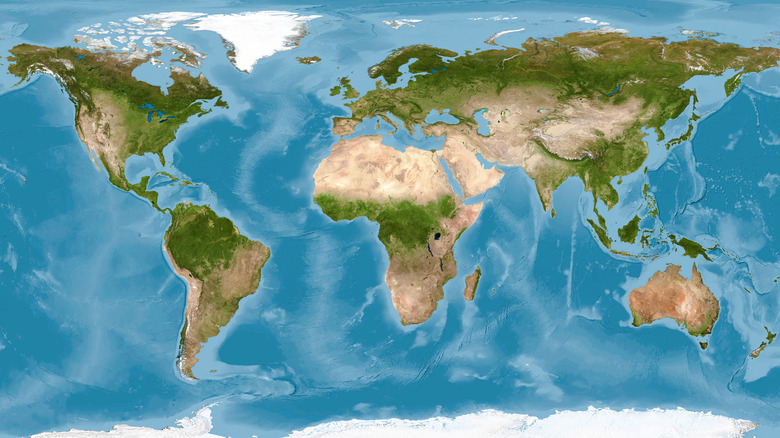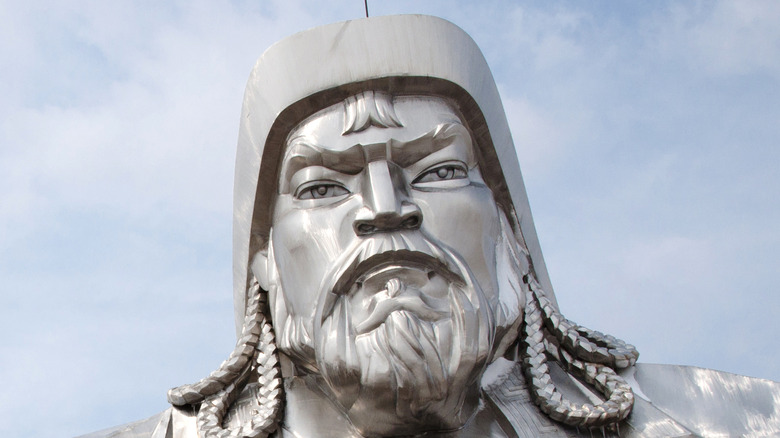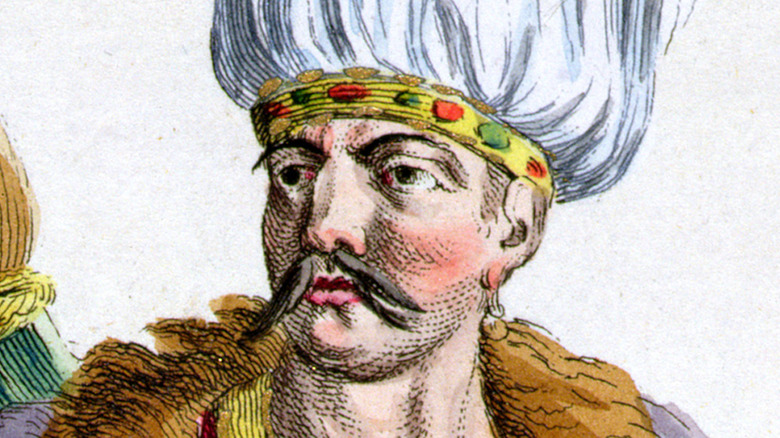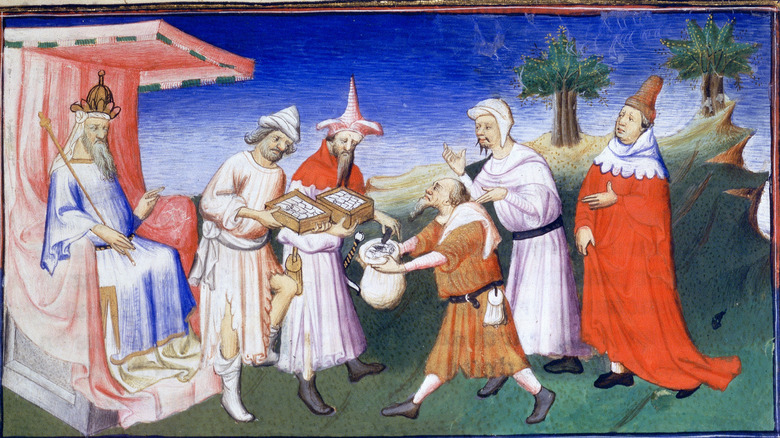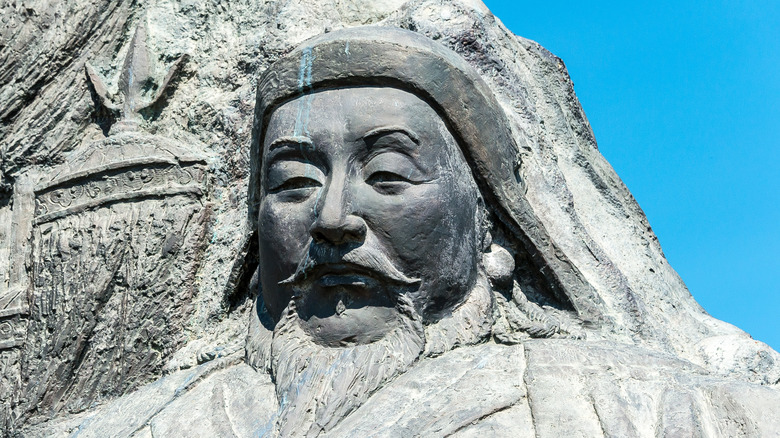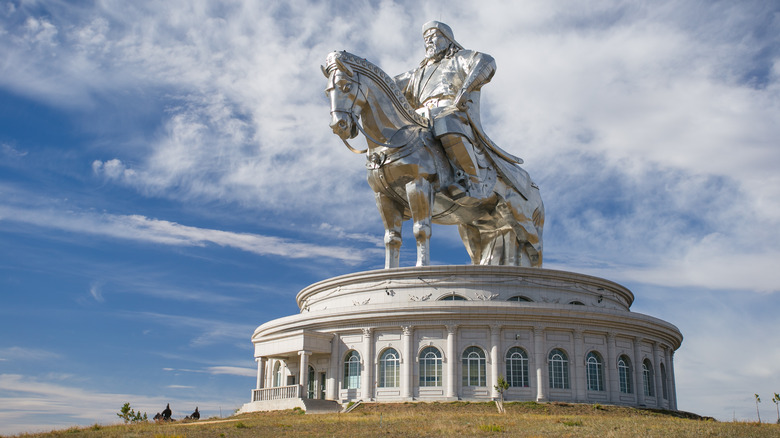What Was The Largest Contiguous Land Empire In World History?
It's fair to say geography is not necessarily everyone's strong suit. Add historical bodies of land into the mix, and it gets even more complicated. As the years pass, people tend to forget things they learned in school. And when it comes to how old the planet actually is — and how its existence includes millions of years of history — it's even harder to remember what existed before our time.
When thinking of the largest contiguous empires (in other words, empires with countries that share borders, and excluding countries with multiple overseas territories) to ever exist, the Roman Empire, the Soviet Union, and present-day Russia or Canada may come to mind. However, what many would view now as a rather unassuming country in Asia gives us a hint as to what was the largest contiguous land empire in history. Situated between Russia and China is the large but sparsely populated nation of Mongolia. Perhaps its name is already ringing a bell.
Genghis Khan unified tribes in modern-day Mongolia
As Encyclopedia.com notes, the man credited for the formation of the largest contiguous land empire is Genghis Khan, who ruled over the Mongolian empire in the 12th century. Born Temüjin in 1162, Genghis Khan's father, Yesugei, was poisoned by a member of a rival tribe in the nearby land. Temüjin, his siblings, and his mother managed to survive by avoiding the other tribes of present-day Mongolia in the steppe region of Asia. They nearly starved due to the steppe's lack of vegetation and long winters.
After persevering through his childhood, Genghis Khan grew up to marry a woman named Borte, a marriage with whom his father had arranged for him years before with Borte's father, a nearby chieftain, per Encyclopedia. The union formed an alliance between both of the tribes their families ruled. As a ruler, Genghis Khan used this as a jumping-off point, gaining the support of other tribes as well, while simultaneously warring against other tribes between 1180 and 1206. Ultimately, Genghis Khan's aim was to unite the nomadic tribes of the region. The unification ultimately led to his creation of the Yeke Mongol Ulus — or what we call the Mongolian empire — in 1206, with Khan declared as "ruler of all men" (via Encyclopedia.com).
Genghis Khan expanded into present-day China
After 1206, Genghis Khan set his sights further into East Asia (via History). His armies first took over lands controlled by the Xi-Xia dynasty in the area around China's present-day Ningxia and Gansu provinces. By 1215, the Mongolian leader moved on to a larger kingdom governed by Jurchen rulers of the Jin dynasty, capturing its capital of Zhongdu, located on the same land as China's current capital city of Beijing, per a summary published by National Geographic in 2021. It was a hard-fought battle, one that lasted for approximately 23 years, and was eventually won not by Genghis Khan himself but by his son Ögedei Khan.
As another 2019 National Geographic article noted, the conquests of both the Xi-Xia and Jin dynasties were ruthless. Civilian populations in Xi-Xia territories plummeted, and Khan's armies killed livestock owners and seized their animals in Jin villages. Mongol armies pushed west into central Asia as well. The armies used military technology from the newly conquered people of the Xi-Xia and Jin dynasties in their attacks on the Khwarazmian empire, which spanned Central Asia and parts of Persia, according to a 2012 piece published by the academic journal Medieval Warfare. With this conquest under Genghis Khan's belt, his armies reached the Caspian Sea — over 3,000 miles from present-day Beijing.
The empire reached its peak under Kublai Khan
Following the end of Genghis Khan's rule with his death in 1227, his sons went into the family business, and the Mongol Empire continued its expansion (via ThoughtCo). His empire was sectioned into parcels ruled by his male heirs. Per Britannica, his son Ögedei Khan not only finalized the absorption of territories in present-day China, Iran, and Afghanistan but also moved troops as far as central Europe. Ögedei Khan's forces captured the Russian settlement of Kyiv (now known as the capital of Ukraine) in 1240. While overtaking Kyiv, Mongol troops entered Hungary and Poland, marking the furthest point into Europe reached by Mongolian forces, but withdrew when Ögedei Khan died in 1241 (via Britannica).
Genghis Khan's expansionist influence didn't stop with the following generation, with varying results. His grandson Kublai Khan, for instance, came to power in 1259 but didn't quite have a knack for the same kind of unifying, cultural cohesion that Ghengis Khan possessed. Under his rule, a large number of regional leaders within the Mongolian empire converted to the religions of their respective locations (mainly Buddhism and Islam) — and with it, the empire further drifted from a sense of national cohesion, according to Britannica.
There was no successor upon Kublai Khan's death
During Kublai Khan's time in power, the Mongol empire's territorial expansion technically peaked, but simultaneously began to fracture, per WorldAtlas. The breakup of the empire came in the form of a growing chasm between smaller "khanates," or regions (via World History Encyclopedia). These khanates included the Great Khanate (which eventually became land ruled under the Yuan dynasty in China), Ilkhanate (situated in the southeast and areas of Persia), the Golden Horde (located in the northeastern section of the Mongolian empire), and Chagatai Khanate (in what is now Central Asia). After Kublai Khan's death in 1294, these khanates became autonomous, thanks to a lack of a named successor.
Out of these, the longest-lasting subdivision of the former domain was the Golden Horde in present-day Russia and Ukraine (via ThoughtCo). It survived years of war, but Slavic and Tartar groups rose to prominence in the area — along with the devastating pandemic known as the Black Death. In the late 1400s, the Golden Horde lost battles with the Kingdom of Poland, and then the Ottomans, in 1502 — marking the true end of what had once been the mighty Mongolian empire.
At least 20 countries exist in what was once the Mongolian empire
The lingering questions about the Mongolian empire are twofold: What prompted Genghis Khan's mission to accumulate so much territory, and why did he do so in such a brutal fashion? According to the BBC site History Extra, it seems it might have all been a matter of divine right — the idea that, per the tenets of his religion, the land was rightfully his, and it was his duty to take it. (As History Extra noted, Genghis Khan even went as far as to call himself "the punishment of God.")
So, how big was the Mongolian empire at its peak? Per Vivid Maps, the list of areas ruled by the Mongols was long. In the present day, these countries would include China, North and South Korea, Mongolia, Kazakhstan, Kyrgyzstan, Turkmenistan, Tajikistan, Iran, Iraq, Afghanistan, Uzbekistan, Pakistan, Turkey, Russia, Ukraine, Belarus, Moldova, and Romania. To put all of this into perspective, the territory of the Mongolian empire in 1294 equaled the size of South America, Central America, the entire U.S., and part of Canada combined. With that, it's easy to see that the Mongol Empire was the largest contiguous land empire in world history.
